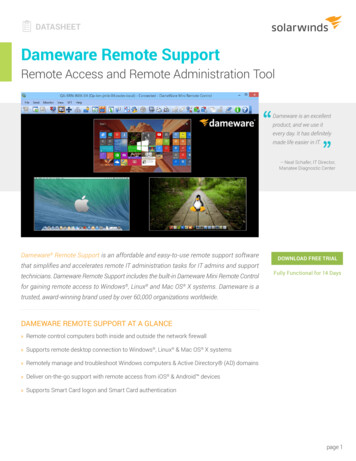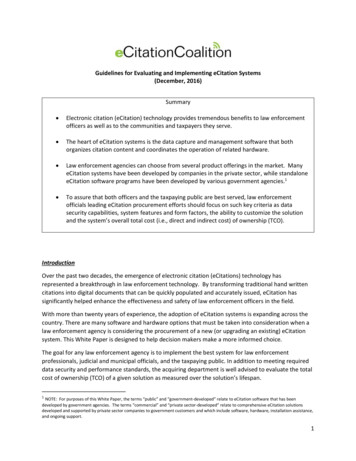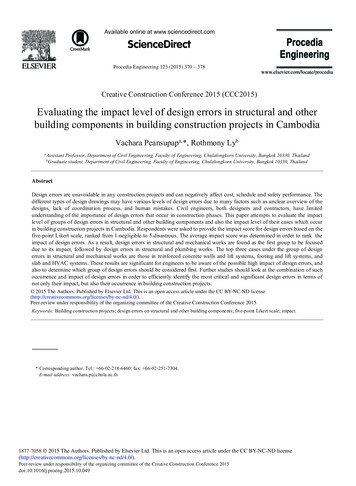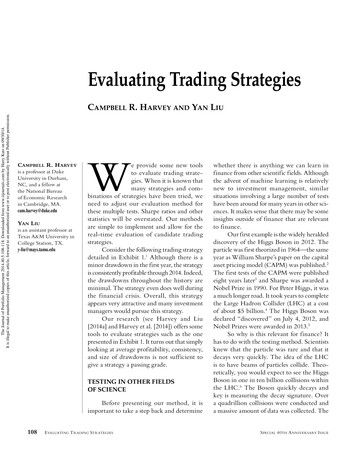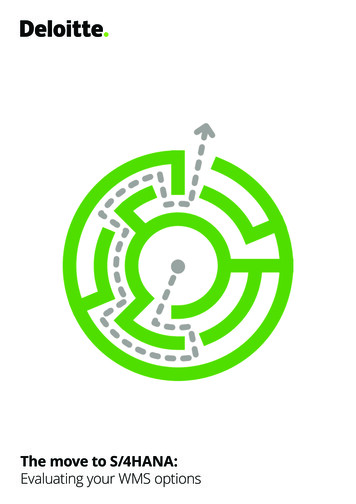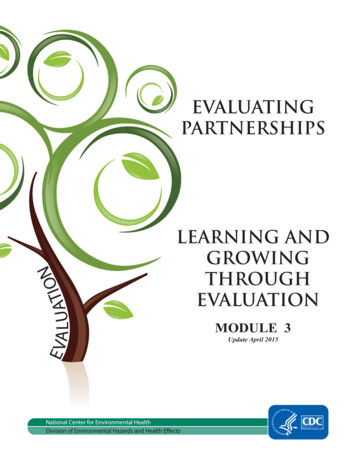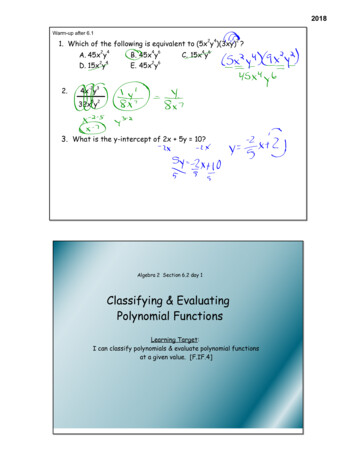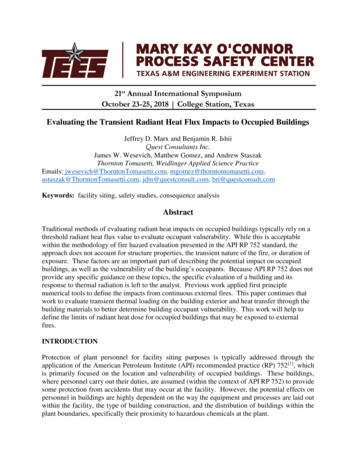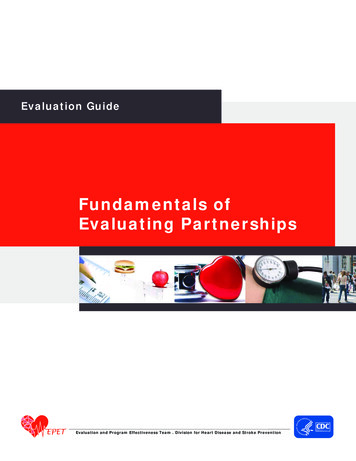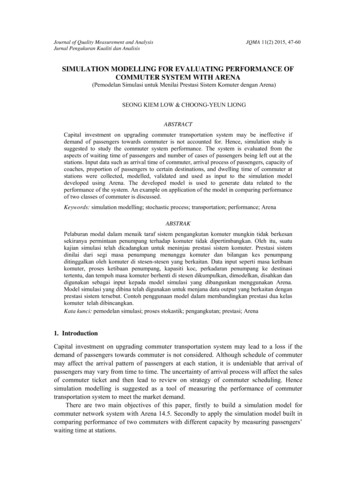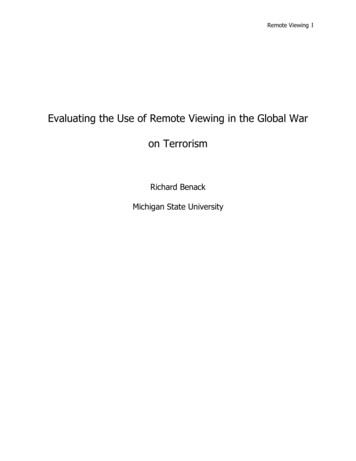
Transcription
Remote ViewingEvaluating the Use of Remote Viewing in the Global Waron TerrorismRichard BenackMichigan State University1
Remote Viewing2Abstract/Executive SummaryThis paper will evaluate the potential application of Remote Viewing (RV) techniques to the Global Waron Terrorism (GWOT). Specifically it will look at how RV can be used to support intelligence andcounterterrorism operations. The paper will rely primarily on declassified government documents on theStargate program. Stargate was the collective name for advanced psychic functioning or Remote Viewingexperiments and programs that were undertaken for twenty years. Its purpose was to create a trainable,repeatable and as much as possible, accurate method of psychic intelligence gathering. By reviewingthese documents, this paper will attempt to determine if remote viewing can be a useful tool in fightingmodem jihadi terrorists.
Remote Viewing3Thesis/Statement of the ProblemFrom 1972 until 1995, several United States military and intelligence organizations conductedparanormal research and operations involving a process known as remote viewing. Remote viewing isgenerally recognized within the scientific community as the psychic ability to access and provide accurateinformation, regardless of distance, shielding or time, about people, places, objects or events inaccessiblethrough any normally recognized means. (Kress, 1999). In 1995, the US government officially confirmedits involvement in RV and psychic phenomenon when it released some of the formerly classified researchthru the Freedom of Information Act.Paranormal research, including Remote Viewing, has been considered a very controversial field inthe American scientific communities. This paper discusses remote viewing's evolution, the role of the USmilitary and intelligence agencies in RV and the potential use of RV as a unique tool for supportinghuman intelligence (HUMINT) and psychological operations (PSYOP) in a counterterrorism role.The premise of this paper is that RV should be investigated as a potential intelligence collectiontool in an all-source intelligence analysis. It should not be considered a standalone single sourceintelligence platform but rather as a way to support and confirm other intelligence sources. In addition, itcan be a useful tool for starting an investigation when no other reliable sources of information areavailable. This situation is especially true when dealing with counterterrorism since traditional technicalintelligence sources are often inadequate. One final advantage of RV is that, based on previous research,there is no known defense against it. Given Islamists fear of what they perceive as ‘black magic’, theremay even be a powerful PSYOP component to using RV.
Remote Viewing4Literature Review.An internet search confirms that there is not much reliable or serious literature on the use ofRemote Viewing (RV) as a counterterrorism tool. A Google search shows almost 880,000 hits on remoteviewing. However, trying to find authoritative information on using RV for intelligence purposes let alonecounterterrorism was extremely difficult. Many of the internet documents were concerned with conspiracytheories such as Area 51 & government UFO cover-ups. A lot of this has to do with misunderstandingwhat RV really is.Remote viewing (RV) is a term for extra-sensory perception, created by Russell Targ and HaroldPuthoff in 1974. Remote viewing is said to allow a "viewer" to use a persons intuitive abilities to gatherinformation on a distant target which is hidden from the physical perception of the viewer. (Puthoff,1984). As would be expected, remote viewing, like many forms of parapsychology, is highly controversialand not widely accepted. There have been a number of studies done on RV and associated phenomenon.A number of these studies have indicated that, some trained viewers were scoring 5%-30% abovechance. Often, though, these reports included a large amount of irrelevant information, and were oftenvague and general in nature. (Bremseth, 2001).Despite this widely held skepticism, the Intelligence community developed a strong interesting inRV and similar phenomenon. During the late 1960s, the United States intelligence community becameconcerned about a perceived disparity between U. S. and Soviet exploration and exploitation ofparanormal phenomena. Intelligence information revealed that the Soviets were spending the equivalentof hundreds of millions of U.S. dollars for research in “distant influencing" and “mind control”. This gap,the so called PSI Gap, was considered a potential national security threat to the United States.(Bremseth, 2001). As a result of this potential threat, a number of projects in parapsychology weredeveloped by multiple intelligence & military organizations.The Stargate Project was one of a number of code names used to cover remote viewingprograms. Others projects included code names such as Sun Streak, Grill Flame and Center Lane. Most ofthis research, however, was based on work done at Stanford Research Institute (SRI).
Remote Viewing5Based on my analysis of a number of declassified documents primarily from the DIA, CIA and theUS Army, The general concern was that whoever made the first major breakthrough in parapsychologycould have a quantum lead over his opponent perhaps even similar to the advantage have having solepossession of nuclear weapons. (Alexander, 1980). It was this fear that helped drive US interest in RV.To some degree there was a feeling; “if the Soviets were putting so much effort in this area then theremust be something to it”. Despite this questionable logic, the intelligence community seemed convincedthat the available evidence supported the thesis that paranormal phenomena do occur and, under somecircumstances, can be controlled. Their views were that psychotronic weapons already exist; only theircapabilities are in doubt. (CI Studies, 1978)One of the earliest authoritative public discussions of the military use of remote viewing was anarticle, The New Mental Battlefield, in the December 1980 edition of Military Review by LTC Alexander. Inthis article, he advocated the introduction of ESP, "tele-pathetic behavior modification," para-psychology,psychokinesis, remote viewing, and other New Age and occult practices into U.S. military intelligence.Alexander describes in detail the Soviet military work in paranormal activity. He also claimed that theSoviets and their allies are well ahead in parapsychological research in areas such as telepathy (themental awareness of information over distance), precognition (the knowledge of future events),telekinesis (movement of matter with the mind) and the transfer of bioenergy from one body to another.(Alexander, 1980) This paper interestingly enough is very popular among the conspiracy theorists whoseem to take this as an exact blueprint of what the US government is currently working on.From PSYOP to Mindwar: The Psychology of Victory (Valley, 1980) was a military paper onpsychological warfare, inspired partly by the New Mental Battlefield article. This paper examines U.S.Psychological Operations (PSYOP) doctrine as of 1980 and proposes radical changes in how PSYOP isimplemented. It advocates integrating parapsychology into PSYOP. It also is very popular among theconspiracy theorists as well.The paper Unconventional Human Intelligence Support: Transcendent and Asymmetric WarfareImplications of Remote Viewing (Bremseth, 2001) is one of the few post 9/11 public documents that
Remote Viewing6seriously advocates using RV in a counterterrorist role. The author argues that the remote viewingprogram's termination was a missed opportunity to more fully explore a potentially new form of warfare.He advocates more fully exploring both remote viewing and human potential enhancement as part of amodern counterterrorism strategy. He makes the following recommendations (Bremseth, 2001):1. Establish a new, broad-based paranormal research program within a single military or intraagency organization. Model the new program from the best features of previous remoteviewing programs but also explore other parapsychological phenomena having potentialmilitary applications2. Follow established scientific protocols in the manner refined by SRI while promoting openminded, creative approaches to paranormal phenomena research and its direct application tomilitary/intelligence planning and operations.Even so, some of the most important documentation on the use of remote viewing in intelligence &counterterrorism is declassified US government documents on RV. In July 1995 the CIA declassified, andapproved for release documents on a program at Stanford Research Institute to determine whetherparapsychological phenomena such as remote viewing might have intelligence collection value. Thisbegan the public disclosure of the intelligence community’s involvement in parapsychological research.Much of this documentation is primarily declassified US Army, CIA and DIA documents covering a numberof issues including1. High level overviews, history and briefings on remote viewing and other parapsychologicalphenomena.2. Methodologies for improving RV techniques and capabilities such as Hypnotism3. Research done for the intelligence community on RV by 3 rd parties such as SRI and SAIC4. The status of selected RV projects including future project goals5. Overviews of various RV methodologies including a number of documents on trainingsessions of Viewers
Remote Viewing76. The threat of Foreign RV intelligence gathering including whether countermeasures may existagainst psycho-energetic intrusions.7. Analysis of the effectiveness of RV as an intelligence gathering tool.The analysis of the literature indicates that RV techniques, done by trained viewers, have between a5-30% success rate and successfully supported a number of military and intelligence operations. (DIA, Nodate). Unfortunately the literature was extremely limited in its discussion on using RV in acounterterrorism role. I suspect that this was due to the fact that at the time, during the cold war, theagencies funding the research were much more concerned about the Soviet Union and its intentions thenterrorism.Overall documents showed that RV results were mixed. However the general trend of my researchindicated that (DIA, No date): Remote viewing is a real phenomenon which is not degraded by distance or shielding. Remote viewing abilities can be developed by appropriate training procedures. Remote viewing has potential for U.S. intelligence applications. Descriptive content (e.g., sketches, configurations) appears to be more reliable than analyticcontent (e.g., function, complex technical data), but progress can be made on the latter.
Remote Viewing8Findings and AnalysisUnderstanding Remote Viewing: Psychoenergetic phenomenon is defined as direct interactionsbetween human consciousness and the environment. Although the mechanism is unexplained, it can beobserved and recorded. These human capabilities fall into two main categories: (1) the acquisition ofinformation, and (2) the production of physical effects. Remote Viewing is the ability to gain access, bymental means alone, to concealed data or remote sites. Remote Action is the ability to influence physicalobjects, by mental means alone. (Puthoff, 1984)The DoD Psychoenergetics Programs primary goals were to evaluate the threat that foreignpsychoenergetics achievements might pose to U.S. national security and explore the potential ofpsychoenergetics in U.S. intelligence collection. Based on over two decades of research and support forintelligence and military operations, the following conclusions on RV can be made (AMSAA, 1979): Descriptive information about remote locations can be obtained that exceeds mere chance. Thequality of information appears to be relatively insensitive to distance or shielding. A remote viewer is able to generate useful data that can be corroborated by other intelligenceassets. This is generally similar to other human intelligence (HUMINT) sources. The information isoften fragmentary and imperfect and is best utilized as part of an all source analysis.Nonetheless, data generated by the RV process appears to constitute an exploitable informationsource.Another declassified intelligence report (DIA, no date) also noted that remote viewing is a realphenomenon that is not degraded by distance or shielding. The DIA believed that this is a talent which isinherent to every human to some degree as and is probably a vestige form of self-preservation. Althoughit is largely ignored in today’s society, through proper training it can be significantly enhanced.The military and intelligence communities attempted to significantly improve the overalleffectiveness & reliability of RV using techniques such as hypnotism. The intelligence community hopedto improve remote viewing capabilities by utilizing a hypnotic trance to increase the amount of targetrelated data produced by a remote viewer. In one study, a strong improvement was seen however in
Remote Viewing9other studies, No statistical improvement were observed. The overall conclusion was that, hypnosis doesnot seem to be a productive way to enhance individual RV capabilities (Lantz, 1989)History of Remote Viewing in intelligence work. Suggestions for military applications of ESP werefirst investigated after World War II. For example, in 1952 the Department of Defense discussed theusefulness of ESP in psychological warfare. Years later, two laser physicists, Dr. Russell Targ and Dr.Harold E. Puthoff, reawakened the governments interest in parapsychology. The Central IntelligenceAgency (CIA) was deeply interested in assessing both the scientific merits and potential intelligence utilityof parapsychology in the early 1970s. Since the 1970s, the CIA and various organizations of theDepartment of Defense (DoD) had funded psychoenergetics (what the government callsparapsychological phenomenon) research thru several programs. The CIA attempted to utilize remoteviewing to collect operational level intelligence. The Defense Intelligence Agency pursued similar goals,but also looked at countermeasures and some aspects of psychokinesis (moving objects with ones mind).The USAF Foreign Technology Division (FTD) was primarily interested in a threat assessment of foreignpsychoenergetics research. Several Army organizations were also heavily involved in the RV research andapplications.(Kress, 1999)The psychoenergetics research sponsored by the CIA and DoD was conducted primarily by SRIInternational. The aim of the programs were to provide research and development in the area ofpsychoenergetics as a means of enhancing human performance for military applications. The researchcentered around three basic program objectives: (1) to document that psychoenergetic phenomena arereal and reproducible; (2) to determine the mechanism's underlying these phenomena; and (3) to bringthe field of psychoenergetics into the mainstream of human performance research, by providing ascientific foundation for this research field. The overall conclusion of the research was that currently weare not at a point where complete and accurate descriptions of many operational targets is possible.Target descriptions by remote viewers still contain a considerable amount of incorrect data with somegood data. However Over the years the research has increased the proportion of good data. (SGIJ, 1989)The US Army, along with the CIA and DIA was one of the 3 major players in this research. In1978, The U.S. Army Intelligence Support Command (INSCOM) set up a program to determine the U.S.
Remote Viewing10military's vulnerability to remote viewing. The first year was to be devoted to training, the second totesting, and the third year to evaluation and reporting. Five months into the first year's training program,the Iran hostage Crisis developed and the training program was terminated. INSCOM's six remoteviewers then became operational. This was one of the earliest attempts to use RV in support of acounterterrorism type operation. INSCOM began receiving a massive number of RV taskings andintelligence support requests from the National Security Council (NSC). One of their first missions was toidentify who among hundreds of Americans in Iran at that time, was actually a hostage. The remoteviewers were successful in identifying all sixty-four American hostages. Further, they identified threeAmericans who were being held at a separate location from the rest of the hostages. Throughout the IranHostage Crisis, the viewers performed over six hundred remote viewings for the NSC including identifyinginfiltration and exfiltration routes for a hostage rescue operation. As a result of this success, INSCOMsoon began receiving weekly remote viewing taskings from the NSA, CIA, DIA, Secret Service, FBI and ahost of federal agencies and organizations. (SGIJ, 1989)DIA also was very involved in RV research. SUN STREAK was a DIA program ''With the objectiveof developing a community-wide capability's for demote viewing”. It was superseded by the STARGATEprogram which was attempting to use a new approach for pursuing a largely unexplored area of humanconsciousness/subconsciousness interaction. STAR GATE was less basic research oriented and morefocused on application research with an emphasis on its impact to U.S. national security. (DIA, 1994)Evaluating the potential effectiveness of the RV in intelligence and counterterrorism : It wasrecognized early that RV had the potential for collecting intelligence-related information that wasotherwise considered inaccessible. INSCOM, for example, routinely obtained target site imagery ofbuildings and other structures, but without HUMINT support, was often unable to determine what wasoccurring within these facilities. RV seemed to be a way of reducing the risk to HUMINT sources andpotentially expanding overall collection and exploitation capabilities. Since counterterrorism is often veryHUMINT intensive, this capability was even more critical.In one RV session, a viewer was given a picture of an aircraft hangar and asked to describe itscontents. In response he produced detailed drawings and three-dimensional models depicting the interior
Remote Viewing11and exterior of a battlefield tank possessing laser optics and computerized targeting systems. The tankwas the still classified U.S. Army M1 tank. (Bremseth, 2001).In another session in 1979, Prompted by KH-9 satellite imagery, the viewer was provided onlythe coordinates of a facility's location and a satellite photo itself. He reported that the Soviets wereconstructing a new class SSBN, which contained eighteen to twenty missile tubes and described thewelding techniques employed in the submarine's construction. Acting upon this information, U.S.intelligence agencies coordinated overhead imagery assets during the period identified and were able toobtain imagery on the Typhoon class SSBN before it submerged at sea. (Bremseth, 2001). Both of theseexample show how RV can be used with imagery intelligence (IMINT) as part of an overall intelligenceanalysis.The DIA identified a number of potential areas where RV could be affective including;counternarcotics, counterterrorism and counterintelligence operations. Specifically, it can be used forfunctions such as; Penetration of Inaccessible Targets and buildings, collecting Science and TechnologyInformation, Identifying Imminent Hostilities, selecting Nuclear and Non-Nuclear Targets, performingHuman Source Assessment and developing Personality Profiles. (DIA, no date)One of the big problems with using RV in an intelligence and counterterrorism role wasunderstanding the limitations of what information could be reliably collected. As Bremseth notes (2001),remote viewing was the intelligence collection tool of last resort. It was employed primarily after moreconventional intelligence col
(Bremseth, 2001). As a result of this potential threat, a number of projects in parapsychology were developed by multiple intelligence & military organizations. The Stargate Project was one of a number of code names used to cover remote viewing programs. Others projects included code names

